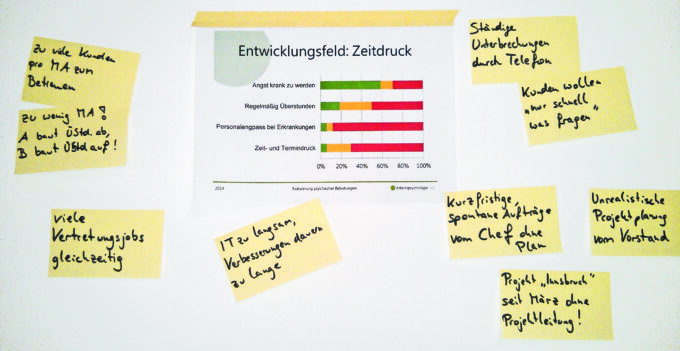Measuring and changing psychosocial risks
More and more companies are recognizing the importance of mental health in the workplace. But how can psychosocial stress be measured and successfully changed? This article provides an overview of the most important aspects in order to be able to provide targeted advice.

Whether due to legal framework conditions or the shortage of skilled workers, which makes it necessary to actively retain employees: There are many reasons to take care of the psyche of employees. Below you will find concrete practical tips on how to get started.
What are mental stresses in the workplace?
Psychological influences that act on people from the outside are called "psychological stresses". The term is basic neither positive nor negative. Here are a few examples:
- Support from the immediate manager
- Information flow in the department
- Room for maneuver when working
- Is the software you work with easy to use?
- Are your contacts polite?
All these factors have an effect on the psyche. This is a completely normal process. Every person is exposed to psychological stress on a daily basis. The effects of mental stress can be positive or negative, depending on whether the work condition is stressful or motivating. They are called "mental stress."
Of course, it is not always clear whether the headache, fatigue or sleep disturbances now come exclusively from work or whether they are also related to private problems.
But when you specifically ask about psychological working conditions, it's not about those effects, it's about the facts around the workplace.
It is similar to hearing loss: This can come from working on loud construction machinery or from loud rock concerts. But if the decibel measurement at the workplace exceeds a threshold value, then specific measures are taken at the workplace. Regardless of whether hearing loss is present or not.
Every person has psychosocial risks at work. The psychological stresses in a job are independent of the person.
How to make psychosocial a topic?
Not every person talks openly about emotions. How can you make psychological working conditions an issue in an organization? Here are three approaches:
- Communicating statistics and scientific correlations: Talking about facts can often be easier than talking about personal involvement. Let them flow in at appropriate opportunities. Example: "Did you know that a lack of recognition for one's work increases the likelihood of heart disease?"
- In personal conversations: Make stressful working conditions, motivating conditions, and also personal feelings a normal topic of conversation. Every conversation about psychological working conditions makes the topic more normal.
- Organization-wide projects: Especially in larger companies, it is a good idea to set up formal projects such as risk assessment of mental stress, sick leave return interviews or company reintegration.
How to measure stress in risk assessment?
This involves the use of occupational psychology measurement methods to obtain a comprehensive picture of the working conditions in an area.There are the following variants here:
- Written questionnaires (online or in paper form)
- Individual or observational interviews with checklists
- Group discussions
Each instrument has its specific advantages. Frequently, several measurement methods are combined within a company.
Each workstation is evaluated separately. The result is not an overall evaluation, but an evaluation for the accounting department, an evaluation for the field service, an evaluation for logistics and so on.
Psychosocial stress: Which preventive measures help?
This cannot be answered in such a general way, because the measures must fit the stress factor. Good measures address the source of the problem and work collectively, i.e. for as many employees as possible.
A well-known basic rule when planning measures is the "STOP principle". It says that one should think about solutions in this order:
- Substitution (can you eliminate the source of the stress?).
- Technical measures (e.g. better software or different room setup)
- Organizational measures (e.g. other work scheduling)
- Person-related measures (e.g. training or coaching)
Let's now apply this to mental stress: In public administration, there are several customer centers with counter workstations. Here, forms can be handed in, questions can be answered and complaints against notices can be made. Citizens are often not in a good mood here and are sometimes even aggressive toward employees. Employees are perceived as the "state personified" and often have to listen to insults for decisions they did not make themselves.
What can be changed now?
- Substitution: The citizens themselves as the perpetrators of aggressive behavior are difficult to change. But it can be checked whether there are factual objections to regulations or frequent misunderstandings due to unclear formulations. If so, these could be changed to avoid such reactions.
- Technical measures: Distance or physical barriers can protect employees. If physical attacks are imminent or have even already occurred, technical measures can help: for example, a glass pane or an emergency button under the desk. Free escape routes (due to possible assaults) should also be ensured.
- Organizational measures: In many cases, these are cost-neutral and can be implemented by the direct manager. This makes them particularly interesting for us. Working alone should be avoided with potentially aggressive persons. Employees should have support within sight or call. A clearly defined procedure and a binding process have a calming effect on employees. There should be no doubt about what to do in the event of verbal abuse or physical attacks. It must also be clear to customers what the consequences of their aggressive behavior will be - for example, through an information campaign.
- Personal measures: Communication or self-defense training can of course be offered as a supplement, but must in no case replace the preceding measures!
Important: The best measures come about when everyone thinks along with you! Therefore, involve the employees as experts for their own workplace in finding solutions.¹
Where are the limits of measures?
- Proposed measures are not always implemented (immediately). And there are several reasons for this:
- No details have been considered and the proposal is so superficial that no one feels they need to change anything ("We should plan our projects better.").
- The measures are too expensive for the management, too costly for the executive or meet with some other resistance. And there is no plan B. So no alternative has been considered.
- The manager sees no need for action and only the team wants to change something. This is where our consulting expertise comes in.
- Or the manager wants to implement measures, but is not responsible and falls on deaf ears with the management (e.g. change of the home office regulation).
After the risk assessment, there are many construction sites on the table and those responsible are overwhelmed with the abundance of measures. As a result, they go into a kind of shock paralysis and do nothing at first. Here, too, consulting competence is required right from the start to set clear priorities and to provide the organization with a plan of action.
Conclusion
Psychosocial stress is a normal aspect of working life. It is worthwhile for companies to actively address this and thus ensure greater motivation and, at the same time, greater efficiency.
¹ Book tip: "Active leadership - How to create motivating working conditions", by Veronika Jakl
About the author: Veronika Jakl, Mag., occupational psychologist and expert for mental stress, Academy Director Pioneers of prevention.










